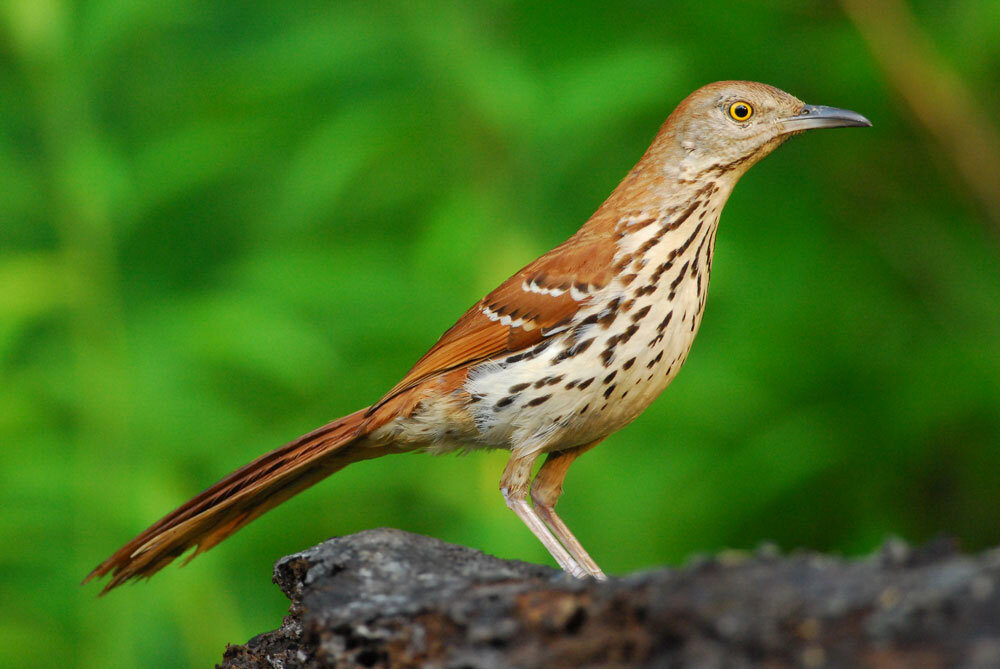Photo: Brown Thrasher, Peter Waksmundzki/Audubon Photography Awards
It’s Easier to Distinguish a Brown Thrasher from a Northern Mockingbird Than You Think
Jessica Bigger
With more than 1100 song variations – some believe that number can be closer to 3000 – the Brown Thrasher (Toxostoma rufum) has one of the largest song repertoires of all songbirds. It even beats out the Northern Mockingbird, which can sing up to 200 different songs. Although their songs can be difficult to distinguish from a Northern Mockingbird’s, the easiest way to tell the two birds apart is to listen to their song phrases. Thrashers only repeat their phrases twice, while mockingbirds repeat their phrases three or more times.
Thrashers also sing with gusto, yet some birders do not understand their singing ability. Cornell mentioned on All About Birds that, “One early naturalist thought the Brown Thrasher’s song was underappreciated, writing “Much of the [acclaim] which has fallen to the Mockingbird is really due to the unperceived efforts of the Brown Thrasher. It is the opinion of many ornithologists that the song… is richer, fuller, and definitely more melodious than that of polyglottis’ (the Northern Mockingbird).
You may be able to hear thrashers in the spring, but they are quite elusive. They nest in thickets, hedgerows and forest edges, but males will fly up to higher branches in trees to sing. You might get a glimpse of them when they come down to forage in the leaf litter, chattering away while searching for food. If you spot one it might give you a scathing look, with its curved bill (frown) and its glaring yellow eyes.
Brown Thrasher, Peter Waksmundzki/Audubon Photography Awards
In Gillian Field’s article in the Herald Times, she wrote about creating habitat to attract a variety of songbirds. Fields had an infestation of vinca minor in her yard. So, she rolled up her sleeves and ripped out every last vine. She replaced the vines with a thick layer of leaves and laid several sticks on top to prevent the leaves from blowing away. To her surprise-two days later-a Brown Thrasher came bopping around her leaf litter, happily chattering away while searching for food.
Some passerines, including the Brown Thrasher, will shed feathers on the underside of their body – known as an “incubation patch.” With their skin feathers free, these birds are able to use their body heat to keep their eggs warm. Feathers would impede this process. Both female and male Brown Thrashers have this patch during the breeding season, as they both share nesting duties.
Thrashers eat both insects and seeds. They also eat fruits, nuts and arthropods. Interestingly, they love acorns. They grab these large nuts in their bill and whack them on the ground to crack the nuts into more manageable pieces.
Brown Thrashers live year-round in the southeastern part of the U.S., but we are blessed to see them in spring and summer as they migrate to Northern Virginia and other eastern states to breed. Although considered a bird of low concern on All About Birds, the Brown Thrasher is considered a vulnerable species according to the National Audubon Society.
Climate change is shifting the Brown Thrasher’s range further north. They are common in Georgia – they are the state bird – but as temperatures rise, the environment is becoming unsuitable for this mimicking species. They’re not the only birds feeling the effects of climate change.
As the earth continues to warm, most of the Brown Thrasher’s current habitat in the U.S., both breeding and nonbreeding, will be lost. The species will be forced to move farther up into Canada. Spring heat waves and heavy rains (which can flood their nests) can endanger nestlings. They are also quite susceptible to nesting parasites, like the Brown Cowbird.
However, there is still hope. Reducing global temperatures, even now, would greatly reduce the chances of a major decline in all bird populations.


